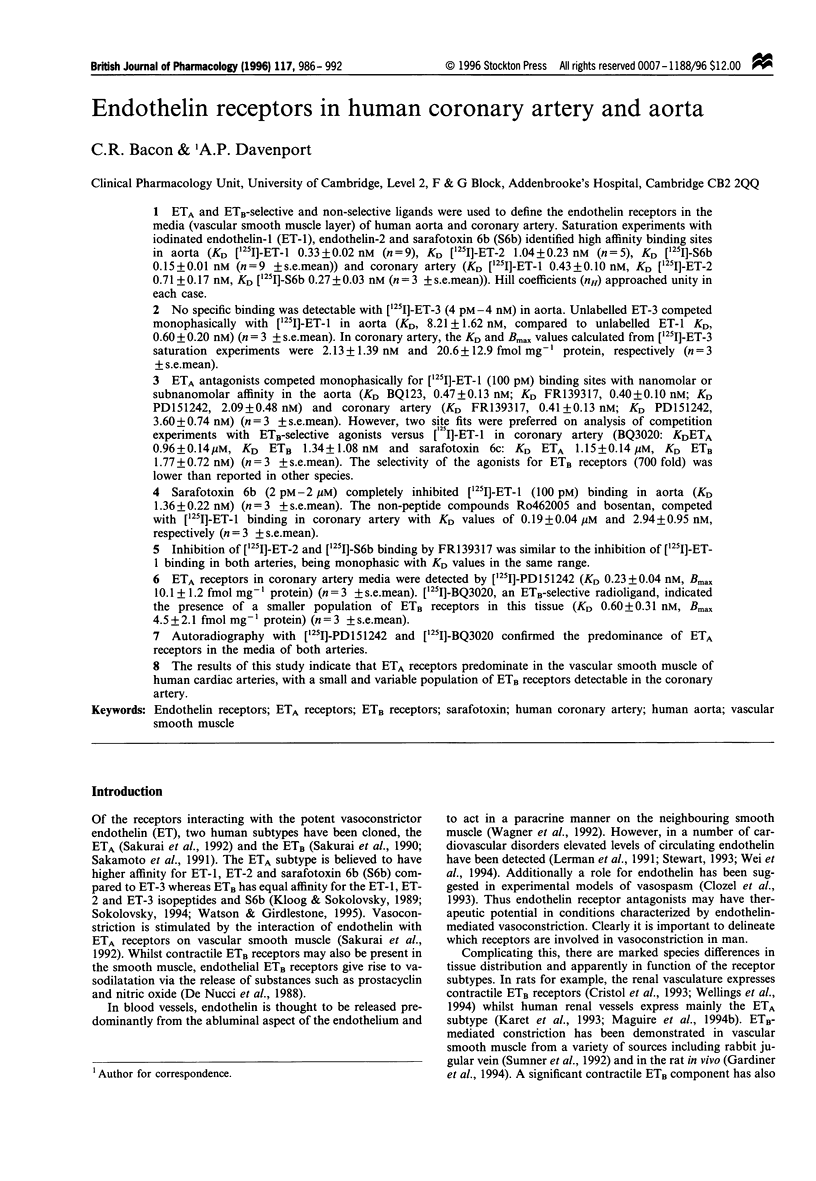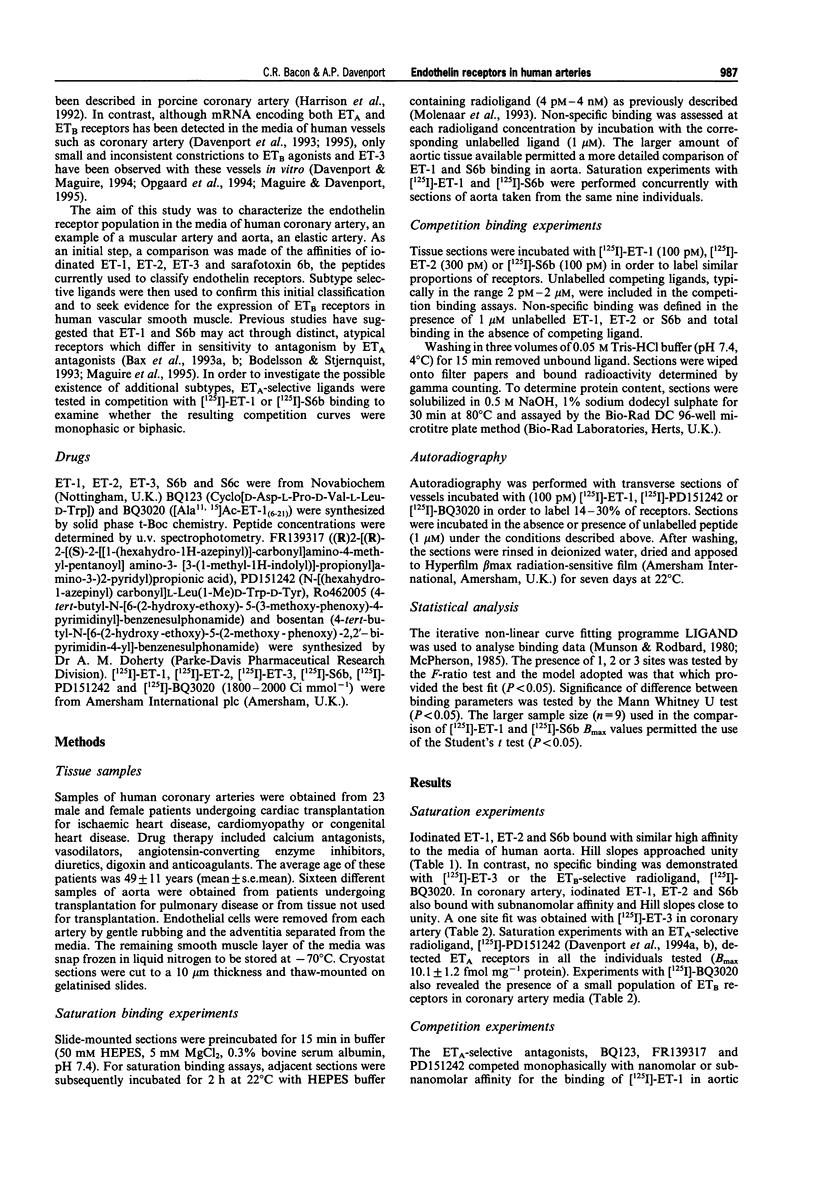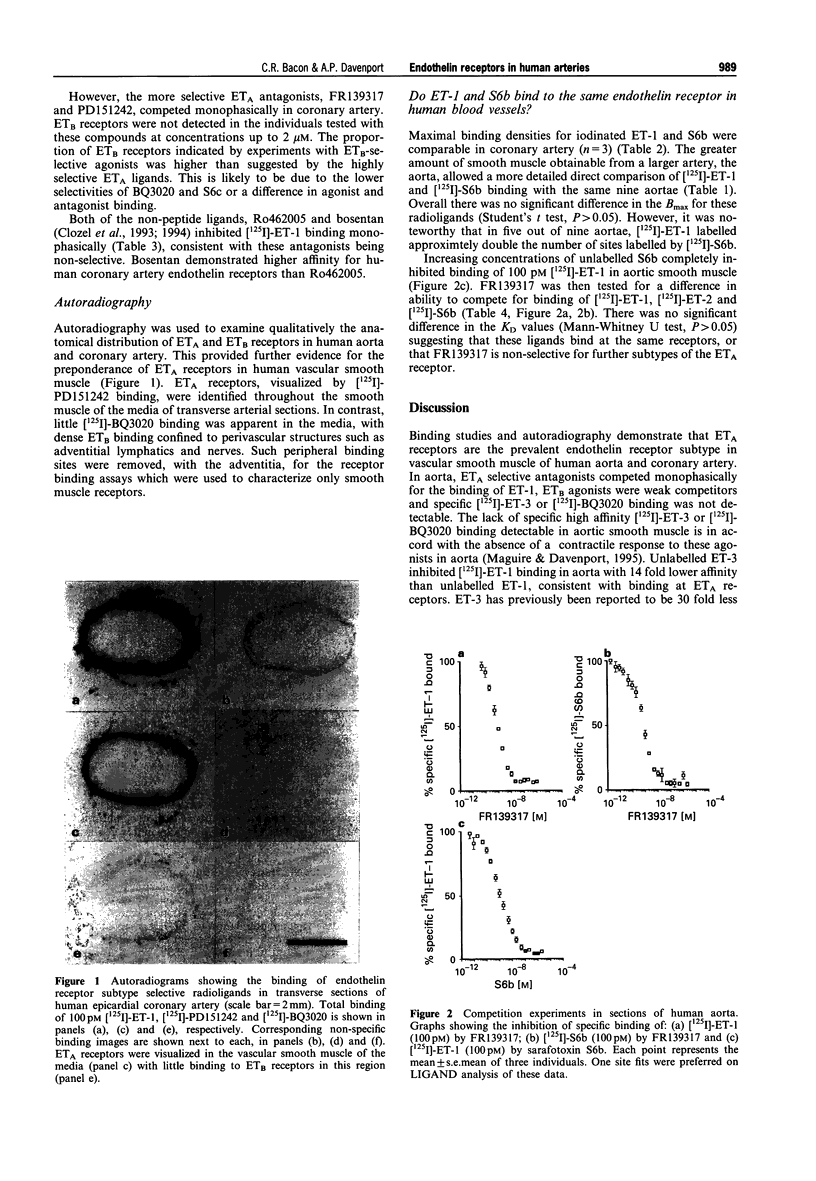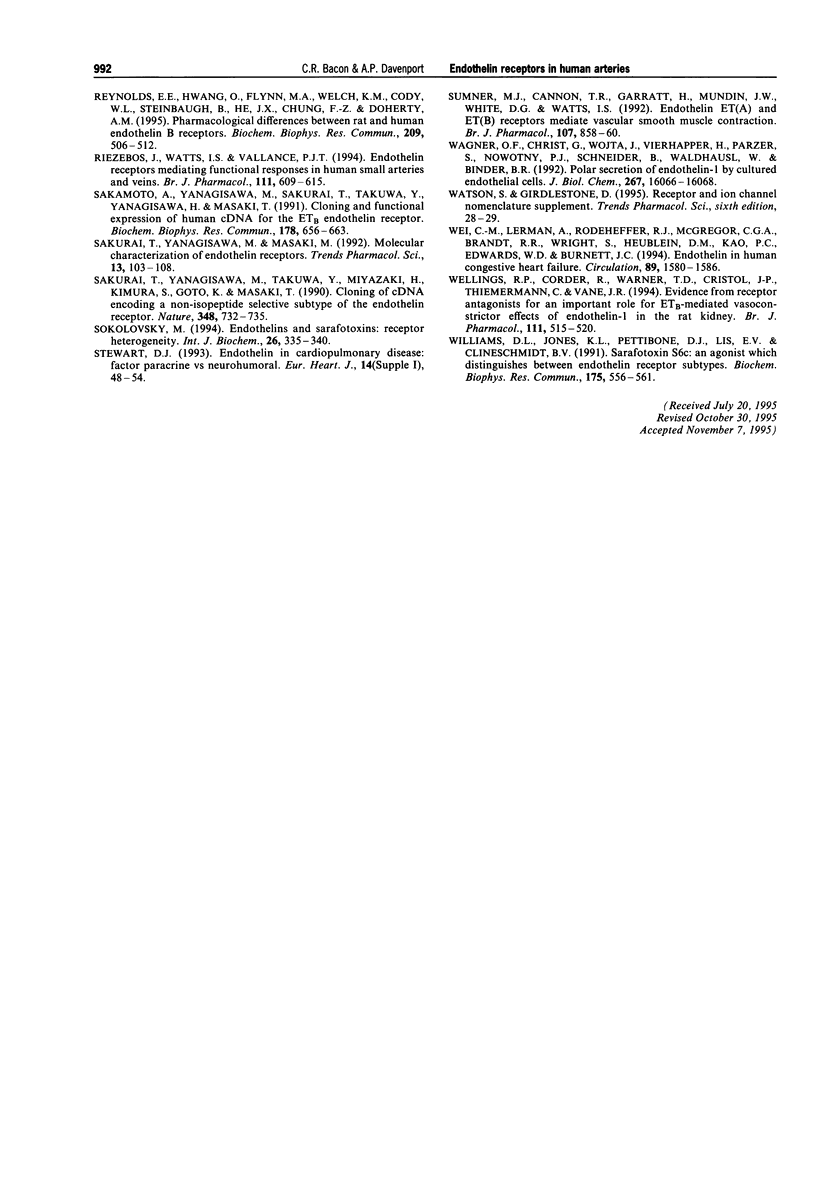Abstract
1. ETA and ETB-selective and non-selective ligands were used to define the endothelin receptors in the media (vascular smooth muscle layer) of human aorta and coronary artery. Saturation experiments with iodinated endothelin-1 (ET-1), endothelin-2 and sarafotoxin 6b (S6b) identified high affinity binding sites in aorta (KD [125I]-ET-1 0.33 +/- 0.02 nM (n = 9), KD [125I]-ET-2 1.04 +/- 0.23 nM (n = 5), KD [125I]-S6b 0.15 +/- 0.01 nM (n = 9 +/- s.e.mean)) and coronary artery (KD [125I]-ET-1 0.43 +/- 0.10 nM, KD [125I]-ET-2 0.71 +/- 0.17 nM, KD [125I]-S6b 0.27 +/- 0.03 nM (n = 3 +/- s.e.mean)). Hill coefficients (nH) approached unity in each case. 2. No specific binding was detectable with [125I]-ET-3 (4 pM-4 nM) in aorta. Unlabelled ET-3 competed monophasically with [125I]-ET-1 in aorta (KD, 8.21 +/- 1.62 nM, compared to unlabelled ET-1 KD, 0.60 +/- 0.20 nM) (n = 3 +/- s.e.mean). In coronary artery, the KD and Bmax values calculated from [125I]-ET-3 saturation experiments were 2.13 +/- 1.39 nM and 20.6 +/- 12.9 fmol mg-1 protein, respectively (n = 3 +/- s.e.mean). 3. ETA antagonists competed monophasically for [125I]-ET-1 (100 pM) binding sites with nanomolar or subnanomolar affinity in the aorta (KD BQ123, 0.47 +/- 0.13 nM; KD FR139317, 0.40 +/- 0.10 nM; KD PD151242, 2.09 +/- 0.48 nM) and coronary artery (KD FR139317, 0.41 +/- 0.13 nM; KD PD151242, 3.60 +/- 0.74 nM) (n = 3 +/- s.e.mean). However, two site fits were preferred on analysis of competition experiments with ETB-selective agonists versus [125I]-ET-1 in coronary artery (BQ3020: KDETA 0.96 +/- 0.14 microM, KD ETB 1.34 +/- 1.08 nM and sarafotoxin 6c: KD ETA 1.15 +/- 0.14 microM, KD ETB 1.77 +/- 0.72 nM) (n = 3 +/- s.e.mean). The selectivity of the agonists for ETB receptors (700 fold) was lower than reported in other species. 4. Sarafotoxin 6b (2 pM-2 microM) completely inhibited [125I]-ET-1 (100 pM) binding in aorta (KD 1.36 +/- 0.22 nM) (n = 3 +/- s.e.mean). The non-peptide compounds Ro462005 and bosentan, competed with [125I]-ET-1 binding in coronary artery with KD values of 0.19 +/- 0.04 microM and 2.94 +/- 0.95 nM, respectively (n = 3 +/- s.e.mean). 5. Inhibition of [125I]-ET-2 and [125I]-S6b binding by FR139317 was similar to the inhibition of [125I]-ET-1 binding in both arteries, being monophasic with KD values in the same range. 6. ETA receptors in coronary artery media were detected by [125I]-PD151242 (KD 0.23 +/- 0.04 nM, Bmax 10.1 +/- 1.2 fmol mg-1 protein) (n = 3 +/- s.e.mean). [125I]-BQ3020, an ETB-selective radioligand, indicated the presence of a smaller population of ETB receptors in this tissue (KD 0.60 +/- 0.31 nM, Bmax 4.5 +/- 2.1 fmol mg-1 protein) (n = 3 +/- s.e.mean). 7. Autoradiography with [125I]-PD151242 and [125I]-BQ3020 confirmed the predominance of ETA receptors in the media of both arteries. 8. The results of this study indicate that ETA receptors predominate in the vascular smooth muscle of human cardiac arteries, with a small and variable population of ETB receptors detectable in the coronary artery.
Full text
PDF






Images in this article
Selected References
These references are in PubMed. This may not be the complete list of references from this article.
- Bacon C. R., Morrison J. J., O'Reilly G., Cameron I. T., Davenport A. P. ETA and ETB endothelin receptors in human myometrium characterized by the subtype selective ligands BQ123, BQ3020, FR139317 and PD151242. J Endocrinol. 1995 Jan;144(1):127–134. doi: 10.1677/joe.0.1440127. [DOI] [PubMed] [Google Scholar]
- Bax W. A., Bos E., Saxena P. R. Heterogeneity of endothelin/sarafotoxin receptors mediating contraction of the human isolated saphenous vein. Eur J Pharmacol. 1993 Aug 3;239(1-3):267–268. doi: 10.1016/0014-2999(93)91010-k. [DOI] [PubMed] [Google Scholar]
- Bax W. A., Bruinvels A. T., van Suylen R. J., Saxena P. R., Hoyer D. Endothelin receptors in the human coronary artery, ventricle and atrium. A quantitative autoradiographic analysis. Naunyn Schmiedebergs Arch Pharmacol. 1993 Oct;348(4):403–410. doi: 10.1007/BF00171340. [DOI] [PubMed] [Google Scholar]
- Bodelsson G., Stjernquist M. Characterization of endothelin receptors and localization of 125I-endothelin-1 binding sites in human umbilical artery. Eur J Pharmacol. 1993 Nov 16;249(3):299–305. doi: 10.1016/0014-2999(93)90526-n. [DOI] [PubMed] [Google Scholar]
- Buchan K. W., Alldus C., Christodoulou C., Clark K. L., Dykes C. W., Sumner M. J., Wallace D. M., White D. G., Watts I. S. Characterization of three non-peptide endothelin receptor ligands using human cloned ETA and ETB receptors. Br J Pharmacol. 1994 Aug;112(4):1251–1257. doi: 10.1111/j.1476-5381.1994.tb13218.x. [DOI] [PMC free article] [PubMed] [Google Scholar]
- Clozel M., Breu V., Burri K., Cassal J. M., Fischli W., Gray G. A., Hirth G., Löffler B. M., Müller M., Neidhart W. Pathophysiological role of endothelin revealed by the first orally active endothelin receptor antagonist. Nature. 1993 Oct 21;365(6448):759–761. doi: 10.1038/365759a0. [DOI] [PubMed] [Google Scholar]
- Clozel M., Breu V., Gray G. A., Kalina B., Löffler B. M., Burri K., Cassal J. M., Hirth G., Müller M., Neidhart W. Pharmacological characterization of bosentan, a new potent orally active nonpeptide endothelin receptor antagonist. J Pharmacol Exp Ther. 1994 Jul;270(1):228–235. [PubMed] [Google Scholar]
- Cristol J. P., Warner T. D., Thiemermann C., Vane J. R. Mediation via different receptors of the vasoconstrictor effects of endothelins and sarafotoxins in the systemic circulation and renal vasculature of the anaesthetized rat. Br J Pharmacol. 1993 Mar;108(3):776–779. doi: 10.1111/j.1476-5381.1993.tb12877.x. [DOI] [PMC free article] [PubMed] [Google Scholar]
- Davenport A. P., Kuc R. E., Hoskins S. L., Karet F. E., Fitzgerald F. [125I]-PD151242: a selective ligand for endothelin ETA receptors in human kidney which localizes to renal vasculature. Br J Pharmacol. 1994 Dec;113(4):1303–1310. doi: 10.1111/j.1476-5381.1994.tb17140.x. [DOI] [PMC free article] [PubMed] [Google Scholar]
- Davenport A. P., Maguire J. J. Is endothelin-induced vasoconstriction mediated only by ETA receptors in humans? Trends Pharmacol Sci. 1994 Jan;15(1):9–11. doi: 10.1016/0165-6147(94)90120-1. [DOI] [PubMed] [Google Scholar]
- Davenport A. P., O'Reilly G., Kuc R. E. Endothelin ETA and ETB mRNA and receptors expressed by smooth muscle in the human vasculature: majority of the ETA sub-type. Br J Pharmacol. 1995 Mar;114(6):1110–1116. doi: 10.1111/j.1476-5381.1995.tb13322.x. [DOI] [PMC free article] [PubMed] [Google Scholar]
- Gardiner S. M., Kemp P. A., March J. E., Bennett T., Davenport A. P., Edvinsson L. Effects of an ET1-receptor antagonist, FR139317, on regional haemodynamic responses to endothelin-1 and [Ala11,15]Ac-endothelin-1 (6-21) in conscious rats. Br J Pharmacol. 1994 Jun;112(2):477–486. doi: 10.1111/j.1476-5381.1994.tb13098.x. [DOI] [PMC free article] [PubMed] [Google Scholar]
- Godfraind T. Evidence for heterogeneity of endothelin receptor distribution in human coronary artery. Br J Pharmacol. 1993 Nov;110(3):1201–1205. doi: 10.1111/j.1476-5381.1993.tb13942.x. [DOI] [PMC free article] [PubMed] [Google Scholar]
- Grossman E., Rosenthal T., Peleg E., Holmes C., Goldstein D. S. Oral yohimbine increases blood pressure and sympathetic nervous outflow in hypertensive patients. J Cardiovasc Pharmacol. 1993 Jul;22(1):22–26. doi: 10.1097/00005344-199307000-00004. [DOI] [PubMed] [Google Scholar]
- Harrison V. J., Randriantsoa A., Schoeffter P. Heterogeneity of endothelin-sarafotoxin receptors mediating contraction of pig coronary artery. Br J Pharmacol. 1992 Mar;105(3):511–513. doi: 10.1111/j.1476-5381.1992.tb09009.x. [DOI] [PMC free article] [PubMed] [Google Scholar]
- Karet F. E., Kuc R. E., Davenport A. P. Novel ligands BQ123 and BQ3020 characterize endothelin receptor subtypes ETA and ETB in human kidney. Kidney Int. 1993 Jul;44(1):36–42. doi: 10.1038/ki.1993.210. [DOI] [PubMed] [Google Scholar]
- Kloog Y., Sokolovsky M. Similarities in mode and sites of action of sarafotoxins and endothelins. Trends Pharmacol Sci. 1989 Jun;10(6):212–214. doi: 10.1016/0165-6147(89)90261-7. [DOI] [PubMed] [Google Scholar]
- Lerman A., Edwards B. S., Hallett J. W., Heublein D. M., Sandberg S. M., Burnett J. C., Jr Circulating and tissue endothelin immunoreactivity in advanced atherosclerosis. N Engl J Med. 1991 Oct 3;325(14):997–1001. doi: 10.1056/NEJM199110033251404. [DOI] [PubMed] [Google Scholar]
- Maguire J. J., Bacon C. R., Fujimoto M., Davenport A. P. Myricerone caffeoyl ester (50-235) is a non-peptide antagonist selective for human ETA receptors. J Hypertens. 1994 Jun;12(6):675–680. [PubMed] [Google Scholar]
- Maguire J. J., Davenport A. P. ETA receptor-mediated constrictor responses to endothelin peptides in human blood vessels in vitro. Br J Pharmacol. 1995 May;115(1):191–197. doi: 10.1111/j.1476-5381.1995.tb16338.x. [DOI] [PMC free article] [PubMed] [Google Scholar]
- Maguire J. J., Kuc R. E., O'Reilly G., Davenport A. P. Vasoconstrictor endothelin receptors characterized in human renal artery and vein in vitro. Br J Pharmacol. 1994 Sep;113(1):49–54. doi: 10.1111/j.1476-5381.1994.tb16172.x. [DOI] [PMC free article] [PubMed] [Google Scholar]
- McPherson G. A. Analysis of radioligand binding experiments. A collection of computer programs for the IBM PC. J Pharmacol Methods. 1985 Nov;14(3):213–228. doi: 10.1016/0160-5402(85)90034-8. [DOI] [PubMed] [Google Scholar]
- Molenaar P., O'Reilly G., Sharkey A., Kuc R. E., Harding D. P., Plumpton C., Gresham G. A., Davenport A. P. Characterization and localization of endothelin receptor subtypes in the human atrioventricular conducting system and myocardium. Circ Res. 1993 Mar;72(3):526–538. doi: 10.1161/01.res.72.3.526. [DOI] [PubMed] [Google Scholar]
- Munson P. J., Rodbard D. Ligand: a versatile computerized approach for characterization of ligand-binding systems. Anal Biochem. 1980 Sep 1;107(1):220–239. doi: 10.1016/0003-2697(80)90515-1. [DOI] [PubMed] [Google Scholar]
- Nambi P., Pullen M. [125I]-BQ3020, a potent ETB-selective agonist, displays species differences in its binding characteristics. Neuropeptides. 1995 Mar;28(3):191–196. doi: 10.1016/0143-4179(95)90115-9. [DOI] [PubMed] [Google Scholar]
- Peter M. G., Davenport A. P. Selectivity of [125I]-PD151242 for human, rat and porcine endothelin ETA receptors in the heart. Br J Pharmacol. 1995 Jan;114(2):297–302. doi: 10.1111/j.1476-5381.1995.tb13226.x. [DOI] [PMC free article] [PubMed] [Google Scholar]
- Reynolds E. E., Hwang O., Flynn M. A., Welch K. M., Cody W. L., Steinbaugh B., He J. X., Chung F. Z., Doherty A. M. Pharmacological differences between rat and human endothelin B receptors. Biochem Biophys Res Commun. 1995 Apr 17;209(2):506–512. doi: 10.1006/bbrc.1995.1530. [DOI] [PubMed] [Google Scholar]
- Riezebos J., Watts I. S., Vallance P. J. Endothelin receptors mediating functional responses in human small arteries and veins. Br J Pharmacol. 1994 Feb;111(2):609–615. doi: 10.1111/j.1476-5381.1994.tb14780.x. [DOI] [PMC free article] [PubMed] [Google Scholar]
- Saetrum Opgaard O., Adner M., Gulbenkian S., Edvinsson L. Localization of endothelin immunoreactivity and demonstration of constrictory endothelin-A receptors in human coronary arteries and veins. J Cardiovasc Pharmacol. 1994 Apr;23(4):576–583. doi: 10.1097/00005344-199404000-00009. [DOI] [PubMed] [Google Scholar]
- Sakamoto A., Yanagisawa M., Sakurai T., Takuwa Y., Yanagisawa H., Masaki T. Cloning and functional expression of human cDNA for the ETB endothelin receptor. Biochem Biophys Res Commun. 1991 Jul 31;178(2):656–663. doi: 10.1016/0006-291x(91)90158-4. [DOI] [PubMed] [Google Scholar]
- Sakurai T., Yanagisawa M., Masaki T. Molecular characterization of endothelin receptors. Trends Pharmacol Sci. 1992 Mar;13(3):103–108. doi: 10.1016/0165-6147(92)90038-8. [DOI] [PubMed] [Google Scholar]
- Sakurai T., Yanagisawa M., Takuwa Y., Miyazaki H., Kimura S., Goto K., Masaki T. Cloning of a cDNA encoding a non-isopeptide-selective subtype of the endothelin receptor. Nature. 1990 Dec 20;348(6303):732–735. doi: 10.1038/348732a0. [DOI] [PubMed] [Google Scholar]
- Sokolovsky M. Endothelins and sarafotoxins: receptor heterogeneity. Int J Biochem. 1994 Mar;26(3):335–340. doi: 10.1016/0020-711x(94)90053-1. [DOI] [PubMed] [Google Scholar]
- Stewart D. J. Endothelin in cardiopulmonary disease: factor paracrine vs neurohumoral. Eur Heart J. 1993 Nov;14 (Suppl 1):48–54. [PubMed] [Google Scholar]
- Sumner M. J., Cannon T. R., Mundin J. W., White D. G., Watts I. S. Endothelin ETA and ETB receptors mediate vascular smooth muscle contraction. Br J Pharmacol. 1992 Nov;107(3):858–860. doi: 10.1111/j.1476-5381.1992.tb14537.x. [DOI] [PMC free article] [PubMed] [Google Scholar]
- Wagner O. F., Christ G., Wojta J., Vierhapper H., Parzer S., Nowotny P. J., Schneider B., Waldhäusl W., Binder B. R. Polar secretion of endothelin-1 by cultured endothelial cells. J Biol Chem. 1992 Aug 15;267(23):16066–16068. [PubMed] [Google Scholar]
- Wei C. M., Lerman A., Rodeheffer R. J., McGregor C. G., Brandt R. R., Wright S., Heublein D. M., Kao P. C., Edwards W. D., Burnett J. C., Jr Endothelin in human congestive heart failure. Circulation. 1994 Apr;89(4):1580–1586. doi: 10.1161/01.cir.89.4.1580. [DOI] [PubMed] [Google Scholar]
- Wellings R. P., Corder R., Warner T. D., Cristol J. P., Thiemermann C., Vane J. R. Evidence from receptor antagonists of an important role for ETB receptor-mediated vasoconstrictor effects of endothelin-1 in the rat kidney. Br J Pharmacol. 1994 Feb;111(2):515–520. doi: 10.1111/j.1476-5381.1994.tb14767.x. [DOI] [PMC free article] [PubMed] [Google Scholar]
- Williams D. L., Jr, Jones K. L., Pettibone D. J., Lis E. V., Clineschmidt B. V. Sarafotoxin S6c: an agonist which distinguishes between endothelin receptor subtypes. Biochem Biophys Res Commun. 1991 Mar 15;175(2):556–561. doi: 10.1016/0006-291x(91)91601-8. [DOI] [PubMed] [Google Scholar]
- de Nucci G., Thomas R., D'Orleans-Juste P., Antunes E., Walder C., Warner T. D., Vane J. R. Pressor effects of circulating endothelin are limited by its removal in the pulmonary circulation and by the release of prostacyclin and endothelium-derived relaxing factor. Proc Natl Acad Sci U S A. 1988 Dec;85(24):9797–9800. doi: 10.1073/pnas.85.24.9797. [DOI] [PMC free article] [PubMed] [Google Scholar]



